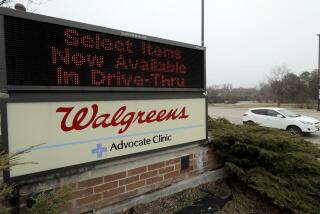Walgreen Sees Silver Lining to Graying of America
- Share via
CHICAGO — Old-age jokes and cracks about aches, pains and faulty memories carry special jollity these days at Walgreen Co.
It’s no wonder. Barring the discovery of a fountain of youth, the fast-spreading drugstore chain thinks it has a perfect prescription for growth: the steady aging of baby boomers.
Walgreen’s top executives, cheerfully counting themselves among the “gray heads,” drew laughs at the company’s annual meeting this month with jokes such as this one:
Why did the aging person cross the road?
Answer: There’s a 24-hour pharmacy on the other side.
Not worthy of Jay Leno, but it’s humor that reflects the confidence of a company opening a new Walgreens drugstore an average of every 17 hours.
“The scenario of an aging population in pursuit of youthfulness, seeking out and willing to pay for health-care and personal-care products, is like something in a dream,” President David Bernauer, 56, told shareholders. “If you went to pharmacy heaven, this would be it.”
Well-Positioned to Continue Growth
Even as the economy slows, industry experts say Walgreen--which itself hits the ripe old age of 100 this year--is well-positioned to not only extend its 26-year streak of annual earnings growth, but also to benefit increasingly from a steep rise in U.S. prescriptions.
The Deerfield, Ill.-based company has been concentrating more on its pharmacy business, where prescriptions have grown from 15% of sales in 1980 to 57% today.
“The economy doesn’t really make any difference” in the company’s long-term strategy, said Mark Husson, an analyst at Merrill Lynch Global Securities. “We’re getting older, we’re getting grayer and we’re getting iller. Walgreen is in the right place at the right time for that.”
Gray, old Walgreen might seem staid and traditional, but it has a record of innovation dating back to its founding in 1901, when Swedish immigrant Charles Walgreen paid $6,000 to buy the Chicago South Side drugstore where he worked as a pharmacist.
The company had one of the first soda fountains in the 1920s, pioneered the switch from total clerk-service to self-service stores with large pharmacies in the late ‘40s and ‘50s, and was an early convert to computer technology in the ‘80s, according to the trade publication Drug Store News. Walgreen also led the industry a decade ago in establishing drive-through pharmacies--now a staple of the trade.
About the same time, the company studied the changing U.S. demographics and embarked on a bolder expansion strategy. It bought up prime, high-traffic sites and started building its own free-standing stores, a shift away from mall locations.
After opening about 100 stores annually for much of the ‘90s, Walgreen increased its store count by 344 last year. It now boasts about 3,300 stores in 43 states and Puerto Rico, employing 116,000 people, and has a growing online business.
New Stores Opening in Sun-Belt States
A third of its stores are losing money because they’re so new--stores generally take two to three years to become profitable. But with corporate profits still rising 24% last year, Chief Executive Daniel Jorndt isn’t backing off a plan to add 500 stores this year and to reach 6,000 within a decade.
A prime reason: With the population aging and more blockbuster drugs being developed, Westport, Conn.-based research firm IMS Health Inc. estimates that 3.7 billion prescriptions will be written in the United States in 2004, 1 billion more than in 1999.
“We can’t grow stores fast enough as an industry to keep up with the growth in prescriptions,” Bernauer said.
Many of the new Walgreens are being opened in Sun Belt states--California, Florida, Texas, Arizona, Georgia and the Carolinas--”because that’s where the baby boomers will retire and prescription sales will explode,” he said.
The only dark cloud on the horizon is a nationwide shortage of trained pharmacists.
Walgreen also has a wary eye on top rival CVS Inc., which operates only east of the Mississippi River. Woonsocket, R.I.-based CVS has an industry-leading 4,100 stores and is a close second to Walgreen’s $21 billion in sales. It is adding more than 100 stores a year.
The other two large U.S. drug chains, Rite Aid and Eckerd, have struggled. That’s not the case with mom-and-pop drugstores, which, according to their trade group, are not worried about Walgreen’s ambitions.
“The market is expanding dramatically,” said Todd Dankmyer of the National Community Pharmacists’ Assn., representing 25,000 independent pharmacies. “There’s plenty of business to go around.”
Walgreen investors hope so. After seeing their stock rise 43% last year, shareholders are giddy, if a bit wary, of their company’s quest to become the McDonald’s of drugstore chains.
“It’s a stunning [expansion] pace and I do have some concerns,” said Dan Van Kirk as he left the annual meeting. “But they are buying into the rising tide of the baby boomers. The management seems to have a pretty good idea of the bumps in the road.”
That road won’t take Walgreen overseas any time soon, as had once been planned.
“For the next few years, it’s full speed ahead right here in the U.S.,” Jorndt said. “There are so many opportunities here.”
On the Net:
https://www.walgreens.com
More to Read
Inside the business of entertainment
The Wide Shot brings you news, analysis and insights on everything from streaming wars to production — and what it all means for the future.
You may occasionally receive promotional content from the Los Angeles Times.










